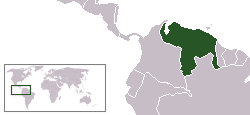Second Republic of Venezuela facts for kids
Quick facts for kids
Republic of Venezuela
República de Venezuela
|
|||||||||||||
|---|---|---|---|---|---|---|---|---|---|---|---|---|---|
| 1813–1814 | |||||||||||||

The Second Republic of Venezuela
|
|||||||||||||
| Status | Unrecognized state | ||||||||||||
| Capital | Caracas | ||||||||||||
| Common languages | Spanish | ||||||||||||
| Government | Republic | ||||||||||||
| President | |||||||||||||
| Historical era | Spanish American wars of independence | ||||||||||||
|
• Admirable Campaign
|
7 August 1813 | ||||||||||||
|
• Conquest
|
16 July 1814 | ||||||||||||
| ISO 3166 code | VE | ||||||||||||
|
|||||||||||||
The Second Republic of Venezuela (which means Second Republic of Venezuela in Spanish) was a government declared by Simón Bolívar on August 7, 1813. This happened after Bolívar defeated the Spanish forces led by Domingo Monteverde. Another leader, Santiago Mariño, also helped by winning battles in the eastern part of Venezuela.
This republic did not last long. It ended the next year, in 1814, after many defeats by the forces of José Tomás Boves. This period was an important part of Venezuela's fight for independence from Spain.
Contents
How the Second Republic Began
Bolívar's Exile and the Cartagena Manifesto
After the first attempt at a Venezuelan Republic failed, Colonel Simón Bolívar had to leave the country. He went to Curaçao, an island nearby. Soon after, he sailed to the United Provinces of New Granada, which is now Colombia. New Granada had also recently declared its independence from the Spanish Empire.
In the city of Cartagena, Bolívar wrote an important letter called the Cartagena Manifesto. In this letter, he explained why the First Republic had fallen. He also shared his ideas about the situation in Hispanic America and what he thought the future of the region should be.
Bolívar's Return to Venezuela
Bolívar asked the government of New Granada to let him join their army. They quickly made him a general and gave him a military post. He then led a quick military campaign between Tunja and Pamplona. He successfully pushed out the Spanish royalist troops from that area.
With the royalists retreating, Bolívar asked the New Granadian government again. He wanted permission to go back into Venezuela with an army of volunteers. Because of his successful actions for New Granada, they agreed to his request. Bolívar then marched his army into Venezuela to fight for its freedom.
The Admirable Campaign
The "Admirable Campaign" was a military operation led by Simón Bolívar in 1813. It was a very fast and successful campaign. Bolívar marched his army from New Granada into Venezuela. During this campaign, his forces won many battles against the Spanish royalists. These victories allowed Bolívar to take control of several important cities, including Caracas. This campaign was key to the declaration of the Second Republic of Venezuela.
The Third Republic of Venezuela
Historians use the name Third Republic of Venezuela to talk about the time from about 1817 to 1819. During this period, a new government led by Bolívar started to work in the plains (Llanos) of Venezuela.
Before this, different Venezuelan rebel groups had managed to set up permanent bases in the Llanos. They also captured the city of Angostura, which became their main headquarters. This period ended with the creation of the Congress of Angostura in 1819. This congress wrote a new constitution for Venezuela. It replaced the old one from 1811, which was technically still valid but had been paused since the First Republic fell in 1812.
The congress decided to unite Venezuela with New Granada. They formed a new large republic called Gran Colombia. This union brought an end to the Third Republic of Venezuela.
From 1820 to 1830, the area of Venezuela was a part of Gran Colombia. After Gran Colombia broke apart, Venezuela became the Republic of Venezuela again. Even though it had different constitutions and governments over time, it has stayed independent ever since. This long period of independence is sometimes called the "Fourth Republic of Venezuela."
See also
 In Spanish: Segunda República de Venezuela para niños
In Spanish: Segunda República de Venezuela para niños


